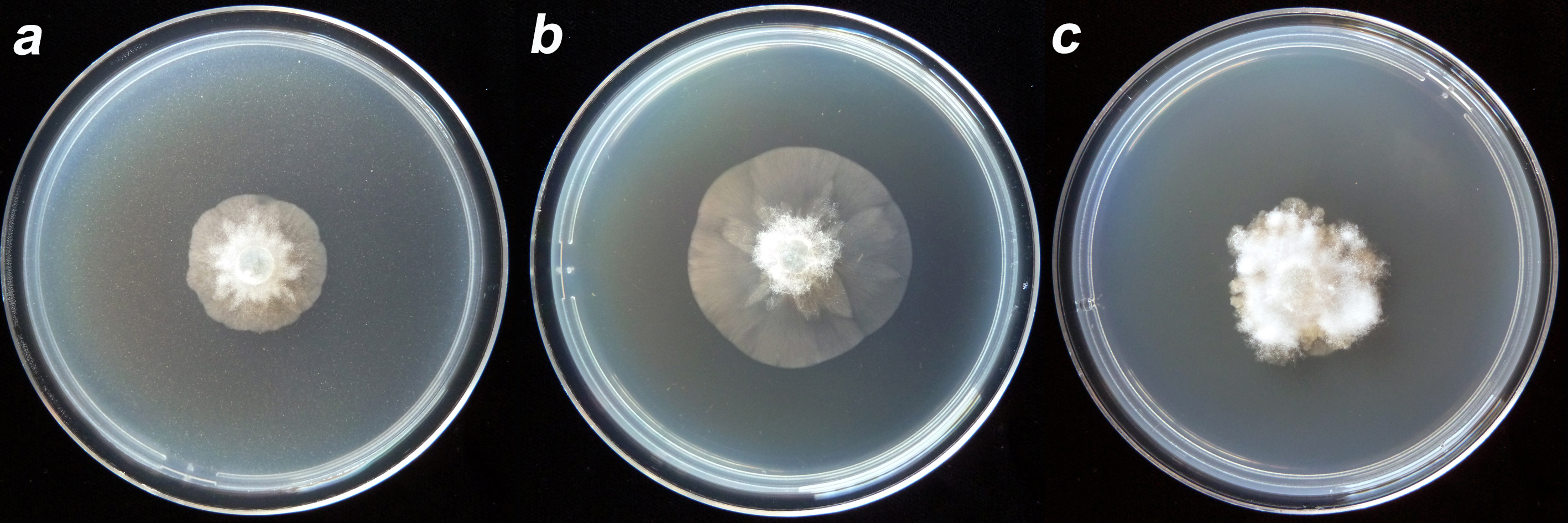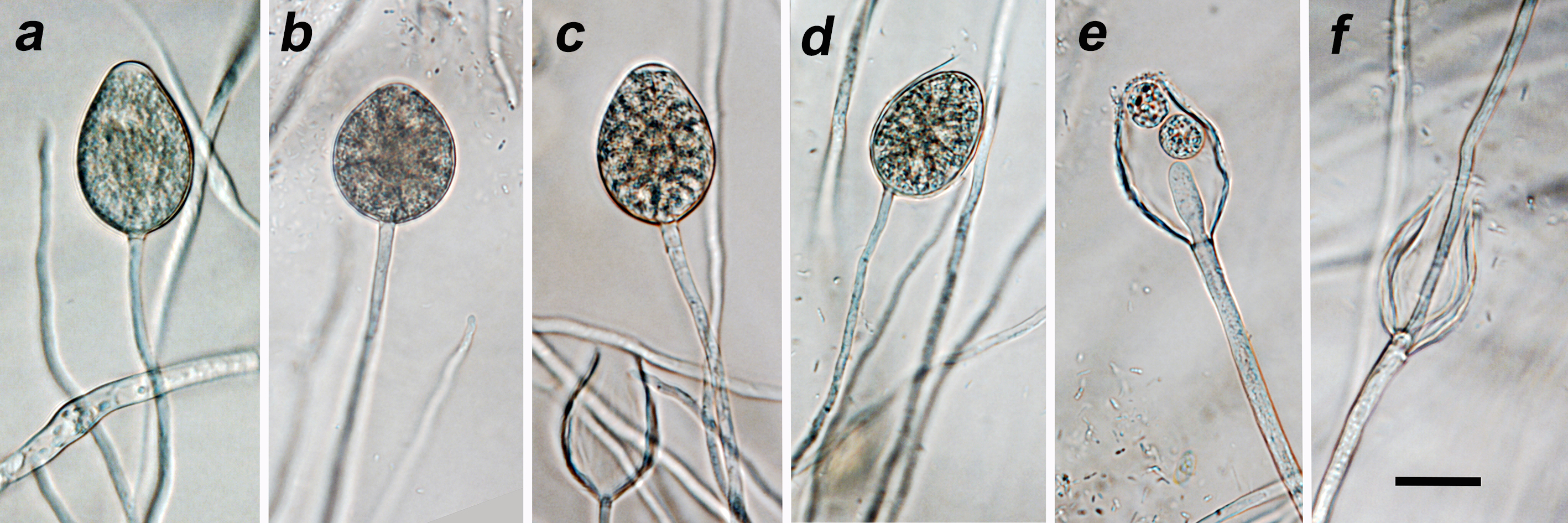Phytophthora moyootj
|
Phytophthora spp. in subclade 6b: portion of the seven-loci ML phylogeny featuring the type cultures of 212 described species (by T. Bourret). Notice the position of P. moyootj Ex-type CBS 138759 = S&T BL 182. Gloria Abad, USDA S&T.
|
|
Phytophthora spp. in subclade 6b: Morphological Tabular key (PDF) and Tabular key legends (PDF) in IDphy2 KEY SECTION. Notice the data of P. moyootj Ex-type CBS 138759 = S&T BL 182. Gloria Abad, USDA S&T.
|
|
Phytophthora moyootj colonies grown for 7 days at 20°C on: (a) V8® agar (b) carrot agar (c) potato dextrose agar; photo by T. Burgess, Centre for Phytophthora Science and Management, Murdoch University, Australia |
|
mature nonpapillate sporangia formed on V8 agar flooded with soil extract: (a, c) ovoid (b) broad ovoid, (d) nested proliferation, (e) ovoid just before release of zoospores, (f) empty sporangia with trapped encysted zoospores, internal nested and extended proliferation; scale bar = 25 µm; photo by T. Burgess, Centre for Phytophthora Science and Management, Murdoch University, Australia
|
Name and publication
Phytophthora moyootj T.I. Burgess (2014)
Burgess TI and Stukely MJC. 2014. Phytophthora moyootj Persoonia 33: 278–279. In Crous P, et al. 2014. Fungal Planet description sheets: 281–319. Persoonia 33: 212–289.
Corresponding author: tburgess@murdoch.edu.au
Nomenclature
from Burgess and Stukely (2014)
Mycobank
Etymology
named for the swamp or wetlands from which isolates were recovered (moyootj = swamp country in the local Aboriginal Nyoongar language)
Typification
Type: AUSTRALIA, Western Australia, Walpole, mud from vehicle, 2012, collected by Department of Parks and Wildlife MURU 469 (dried culture on V8A, Herbarium of Murdoch University, Western Australia)
Ex-type: CBS 138759 = VHS 27218
Sequences for ex-type in original manuscript: VHS 27218: ITS rDNA KJ372256, β-tubulin KJ372303, HSP90 KJ396730, coxI s KJ396702, NADH KJ396681, LSU KP004501
Ex-type in other collections
(ET) CBS 138759, VHS27218, S&T BL 182 (Abad)
Molecular identification
Voucher sequences for barcoding genes (ITS rDNA and COI) of the ex-type (see Molecular protocols page)
Phytophthora moyootj isolate VHS 27218 ITS rDNA KJ372256
Phytophthora moyootj isolate CPHST BL 182 COI MH477750
<Voucher sequences for Molecular Toolbox with seven genes (ITS, β-tub, COI, EF1α, HSP90, L10, and YPT1
(see Molecular protocols page) (In Progress)
Voucher sequences for Metabarcoding High-throughput Sequencing (HTS) Technologies [Molecular Operational Taxonomic Unit (MOTU)]
(see Molecular protocols page) (In Progress)
Sequences with multiple genes for ex-type in other sources
- NCBI: Phytophthora moyootj CPHST BL 182
- NCBI: Phytophthora moyootj VHS 27218
- BOLDSYSTEMS: Phytophthora moyootj (barcoding COI & ITS)
Position in multigenic phylogeny with 7 genes (ITS, β-tub, COI, EF1α, HSP90, L10, and YPT1)
Clade clade:
a taxonomic group of organisms classified together on the basis of homologous features traced to a common ancestor
6b
Morphological identification
Colonies and cardinal temperatures
Colony colony:
assemblage of hyphae which usually develops form a single source and grows in a coordinated way
morphology is stellate on V8A, CA, and MEA, and irregular and dense-felty on PDA. Minimum growth temperature 10°C, optimum 25–30°C, and maximum 32.5°C.
Conditions for growth and sporulation
SporangiaSporangia:
sac within which zoospores form, especially when water is cooled to about 10°C below ambient temperature; in solid substrates, sporangia usually germinate by germ tubes
are produced in water cultures (soil extract or river water) and not observed in solid media. OogoniaOogonia:
the female gametangium in which the oospore forms after fertilization by the antheridium
are not observed in single culture or when paired with tester strains.
Asexual phase
SporangiaSporangia:
sac within which zoospores form, especially when water is cooled to about 10°C below ambient temperature; in solid substrates, sporangia usually germinate by germ tubes
are nonpapillatenonpapillate:
pertaining to the production of a non-distinct, or inconspicuous, papilla at the distal end of the sporangium (cf. papillate and semipapillate)
, persistentpersistent:
pertaining to sporangia that remain attached to the sporangiophore and do not separate or detach easily (cf. caducous)
, ovoidovoid:
egg-shaped, with the widest part at the base of the sporangium and the narrow part at the apex
to broad ovoidovoid:
egg-shaped, with the widest part at the base of the sporangium and the narrow part at the apex
or limoniform with average dimensions of 39.6 ± 10.8 x 26.5 ± 4.2 µm (overall range 18–73.3 x 18.3–38.4 µm). Sporangiophores are usually simple, and internal proliferationinternal proliferation:
internal proliferation occurs when the sporangiophore continues to grow through an empty sporangium
, both nested and extended, occurs in chains. Hyphal swellings absent; ChlamydosporesChlamydospores:
an asexual spore with a thickened inner wall that is delimited from the mycelium by a septum; may be terminal or intercalary, and survives for long periods in soil
absent.
Sexual phase
Sterile in culture.
Most typical characters
Phytophthora moyootj is in a species cluster with Phytophthora amnicola, Phytophthora fluvialis, Phytophthora litoralis, and Phytophthora thermophila, all recovered from waterways in Western Australia. Although these species have very similar morphology, P. moyootj is the only one to not produce hyphal swellings or chlamydosporeschlamydospores:
an asexual spore with a thickened inner wall that is delimited from the mycelium by a septum; may be terminal or intercalary, and survives for long periods in soil
.
Specimen(s) evaluated
Australia, Western Australia, Walpole, mud from vehicle, 2012, collected by Department of Parks and Wildlife, CBS 138759 = VHS27218; Fitzgerald River National Park, baited from soil, 2006, VHS16108; Jarrahdale, restored pit at mine site, 2012, collected by D. Hüberli, DH103
Hosts and distribution
Distribution: Australia
Substrate: isolated from soil
Host: no known host
Retrieved January 31, 2018 from U.S. National Fungus Collections Nomenclature Database.
Additional info:
Distribution: Western Australia
Substrate: soil and water
Disease note: no pathogenicity trials have been conducted
Hosts: occasionally isolated in associated with other Phytophthora species in rhizosphaere soil collected in wetter areas
Additional references and links
- SMML USDA-ARS: Phytophthora moyootj
- EPPO Global Database: Phytophthora moyootj
- Forest Phytophthora of the world: Phytophthora moyootj
- CABI Digital Library: Phytophthora moyootj
- Encyclopedia of Life (EOL): Phytophthora moyootj
- Index Fungorum (IF): Phytophthora moyootj
- Google All Phytophthora moyootj
- Google Images Phytophthora moyootj
- Google Scholar Phytophthora moyootj
Fact sheet authors
Treena Burgess, Ph.D., Phytophthora Science and Management, Harry Butler Institute, Murdoch University, Australia
Z. Gloria Abad, Ph.D., USDA-APHIS-PPQ-S&T Plant Pathogen Confirmatory Diagnostics Laboratory (PPCDL), United States of America.



